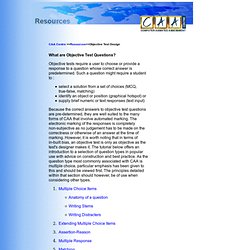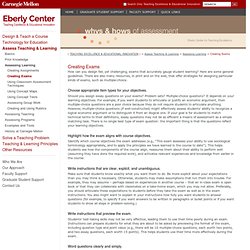

Improving Your Test Questions, Center for Teaching Excellence, University of Illinois. Table of Contents I.

Choosing Between Objective and Subjective Test Items There are two general categories of test items: (1) objective items which require students to select the correct response from several alternatives or to supply a word or short phrase to answer a question or complete a statement; and (2) subjective or essay items which permit the student to organize and present an original answer.
Objective items include multiple-choice, true-false, matching and completion, while subjective items include short-answer essay, extended-response essay, problem solving and performance test items. For some instructional purposes one or the other item types may prove more efficient and appropriate. Ch 22 - Writing & Using Objective Tests. Introduction In ' Assessing Student Performance ', we took a general look at student assessment and identified the various methods that can be used to carry out such assessment, showing how these can be divided into seven broad groups. This booklet takes a detailed look at the first of these groups - objective tests. The booklet begins by describing the generic characteristics of objective tests and discussing their overall strengths and weaknesses. It then examines the different forms that objective test items can take, and offers advice on how to decide which type to use in any given situation. Finally, it provides detailed practical guidance on how to write objective questions of different types, on how to evaluate objective test items, and on how to mark objective tests.
General characteristics of objective tests The main strength of objective tests is the fact that they can be marked with 100% reliability, thus completely eliminating the possibility of marker subjectivity or bias. CAA Centre Resources - Online / Bibliography. Objective tests require a user to choose or provide a response to a question whose correct answer is predetermined.

Such a question might require a student to : select a solution from a set of choices (MCQ, true-false, matching) identify an object or position (graphical hotspot) or supply brief numeric or text responses (text input) Because the correct answers to objective test questions are pre-determined, they are well suited to the many forms of CAA that involve automated marking. The electronic marking of the responses is completely non-subjective as no judgement has to be made on the correctness or otherwise of an answer at the time of marking. However, it is worth noting that in terms of in-built bias, an objective test is only as objective as the test's designer makes it. Caacentre.lboro.ac.uk/dldocs/otghdout.pdf. Creating Effective Classroom Tests - Writing Test Items.
Designing objective test questions. A common criticism of objective tests is they are unable to test higher level learning.

Certainly there is a abundance of questions that test basic recall of facts rather than more demanding intellectual skills. However many have argued that it is possible to write questions that test a range of cognitive skills (e.g. Bull and McKenna 2001). In discussing the writing of such questions reference is usually made to Bloom's taxonomy of educational objectives . Whilst the ability to test the full range of Bloom's educational objectives might be debatable it is certainly possible to write questions that require students to think more deeply.
Think about the learning outcomes for some of your teaching. Work through the tips and examples below and look for ways in which you might be able to create objective questions that test these skills. Tips for writing questions for different stages of Bloom's taxonomy Knowledge and Comprehension Application Analysis and Synthesis Evaluation Example Example. Objective Test Guide. Www.usg.edu/health_workforce_center/09presentations/improving_obj_test_writing_p1.pdf. Creating Exams - Enhancing Education. How can you design fair, yet challenging, exams that accurately gauge student learning?

Here are some general guidelines. There are also many resources, in print and on the web, that offer strategies for designing particular kinds of exams, such as multiple-choice. Choose appropriate item types for your objectives. Should you assign essay questions on your exams? Problem sets? Highlight how the exam aligns with course objectives. Identify which course objectives the exam addresses (e.g., “This exam assesses your ability to use sociological terminology appropriately, and to apply the principles we have learned in the course to date”).
Write instructions that are clear, explicit, and unambiguous. Make sure that students know exactly what you want them to do. Write instructions that preview the exam. Students’ test-taking skills may not be very effective, leading them to use their time poorly during an exam. Word questions clearly and simply. Enlist a colleague or TA to read through your exam.